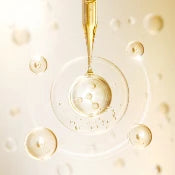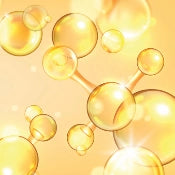In today’s rapidly evolving beauty industry, encapsulation technology is revolutionizing the formulation, stabilization, and delivery of cosmetic actives. No longer confined to pharmaceuticals, encapsulated delivery systems have become essential in high-efficacy skincare formulations, offering enhanced stability, targeted release, and improved sensory experience. As demand grows for potent and long-lasting cosmetic products, encapsulation is now the gold standard for innovation in advanced skincare and personal care solutions.
At Flychem, we develop and supply advanced encapsulated ingredients that enable brands to overcome the limitations of solubility, stability, and bioavailability, delivering maximum performance from every active ingredient. In this blog, we explore the science, systems, and formulation potential of encapsulation in contemporary cosmetic products.
What is Encapsulation in Cosmetics?
Encapsulation is a process where an active ingredient is enclosed within a carrier material or delivery system. This protective matrix can be lipid-based, polymeric, or polysaccharide-based, designed to control release, enhance penetration, protect from degradation, or mask unpleasant odors and textures. Common forms of encapsulation include:
- Liposomal systems
- Nanostructured lipid carriers (NLCs)
- Solid lipid nanoparticles (SLNs)
- Polymeric microcapsules
- Cyclodextrin complexes
- Spray-dried powders
Each method offers distinct advantages based on the nature of the active, formulation type, and target performance.

Why Encapsulation Matters in Cosmetic Science
1. Stability of Sensitive Actives
Ingredients such as Vitamin C, Retinol, and Peptides are notoriously unstable in aqueous environments and when exposed to light, heat, or oxygen. Encapsulation protects these actives from premature degradation, significantly extending shelf life and preserving potency.
2. Controlled and Targeted Release
Encapsulation allows actives to be released over time, upon pH shift, or via skin enzymes, leading to longer-lasting effects and better consumer perception. This is especially important for time-sensitive actives, such as retinoids or exfoliants.
3. Enhanced Penetration and Bioavailability
Smaller particle sizes and compatible carriers allow actives to reach deeper skin layers or hair follicles, increasing clinical efficacy without increasing irritation.
4. Reduced Irritation Potential
By shielding actives until they’re released at the target site, encapsulation can significantly reduce stinging, redness, or sensitivity, crucial for high-performance ingredients in sensitive-skin products.
5. Formulation Versatility
Encapsulated actives can be used in water-based, oil-based, or emulsion systems. Some systems allow clear serum compatibility, even with traditionally oil-based ingredients.
6. Sensorial and Aesthetic Benefits
Encapsulation can mask odor, color, or texture issues, allowing for lighter, more elegant formulas, critical for luxury cosmetic markets.
Popular Encapsulation Systems and Their Applications
1. Liposomal Encapsulation
- Phospholipid bilayers mimic cell membranes
- Excellent for peptides, antioxidants, and botanical extracts
- Ideal for face serums and under-eye treatments
2. NLCs (Nanostructured Lipid Carriers)
- Lipid matrix with solid and liquid lipid phases
- Suitable for anti-aging actives, UV filters, and ceramides
- Superior stability and skin adhesion
3. SLNs (Solid Lipid Nanoparticles)
- Fully solid lipid matrix
- Best for slow-release delivery and skin barrier actives
4. Polymeric Microspheres
- Often used in makeup or sensory-focused actives
-
Controlled release of exfoliants, salicylic acid, or retinoids
5. Cyclodextrin Complexes
- Sugar ring molecules trap volatile actives like fragrances or essential oils
-
Also used to increase the water solubility of lipophilic actives
6. Spray-Dried Actives
- Often combined with maltodextrin or cellulose
-
Cost-effective for heat-sensitive ingredients or powdered actives
Flychem’s Encapsulation Portfolio (Coming Soon)
Flychem offers a growing portfolio of encapsulated ingredients tailored for the needs of Indian, U.S., and global cosmetic brands. Our innovations focus on:
|
Sl. No. |
Product Name |
Form |
|
1 |
Copper Peptide |
Powder |
|
2 |
Copper Peptide |
Liquid |
|
3 |
Niacinamide |
Powder |
|
4 |
3-O-Ethyl Ascorbic Acid |
Powder |
|
5 |
Ceramides Complex |
Liquid |
|
6 |
Ceramides EOP |
Powder |
|
7 |
Alpha Arbutin |
Powder |
|
8 |
Resveratrol |
Liquid |
|
9 |
Ferulic Acid |
Powder |
|
10 |
Retinol |
Powder |
|
11 |
Retinaldehyde |
Powder |
|
12 |
Recombinant Collagen Type-3 |
Liquid |
|
13 |
Caffeine |
Powder |
|
14 |
Acetyl Hexapeptide-8 |
Liquid |
|
15 |
Myristoyl Pentapeptide-7 |
NLCs Liquid |
|
16 |
Dipeptide Diaminobutyroyl Benzalamide |
NLCs Liquid |
|
17 |
Acetyl Tetrapeptide-5 |
NLCs Liquid |
|
18 |
Palmitoyl Tetrapeptide-7 |
NLCs Liquid |
|
19 |
Palmitoyl Tripeptide-1 |
NLCs Liquid |
|
20 |
Oligopeptide-68 |
NLCs Liquid |
|
21 |
Bromelain |
Powder |
|
22 |
Papain |
Powder |
|
23 |
EGF |
Powder |
All Flychem encapsulated actives are designed with pH stability, formulation compatibility, and global regulatory compliance in mind.

Key Considerations for Formulators
- pH compatibility: Some encapsulated systems dissolve or degrade outside target pH ranges.
- Viscosity and suspension: Some capsules require viscosity modification to stay suspended.
- Shear sensitivity: Avoid high-shear mixing after capsule incorporation.
- Storage and packaging: Store in airless or opaque containers if the product is UV-sensitive.
Flychem provides full technical documentation, dispersion guidelines, and recommended co-actives with each encapsulated ingredient.
Regulatory and Marketing Edge
| Region | Regulatory Body | Compatibility with Encapsulation Systems |
| India | BIS | All encapsulated ingredients are compliant. |
| USA | MoCRA | Retinaldehyde, peptides, and NLCs are approved. |
| Europe | REACH | NLCs, SLNs, and liposomes are fully compliant. |
| Middle East | Halal/Vegan Cert. | Available on request. |
Frequently Asked Questions (FAQ): Encapsulation in Cosmetics
What is encapsulation in cosmetic formulation?
Encapsulation involves enclosing active ingredients in carriers, such as liposomes or lipid nanoparticles, to protect, stabilize, and enhance their delivery into the skin.
Why is encapsulation important for Vitamin C or Retinol?
These ingredients are unstable and prone to degradation. Encapsulation shields them from air, light, and moisture, increasing shelf life and potency.
Does encapsulation improve skin absorption?
Yes. Nano-sized particles and lipid-based carriers can penetrate deeper layers of the skin, enhancing bioavailability and performance.
Can encapsulated actives reduce skin irritation?
Absolutely. Controlled release reduces peak concentration on the skin, minimizing irritation, especially with retinoids and acids.
Are encapsulated ingredients safe for all skin types?
When properly formulated, encapsulated ingredients can be safer and gentler, particularly for individuals with sensitive or compromised skin barriers.
How do encapsulated peptides differ from free peptides?
Encapsulated peptides are protected from enzymatic degradation and deliver more sustained activity compared to free peptides.
Are encapsulated ingredients suitable for water-based serums?
Yes. Many modern encapsulation systems (like NLCs or cyclodextrins) are dispersible in water-based or emulsion formats.
What packaging works best for encapsulated actives?
Airless pumps, opaque bottles, or unit-dose formats help prevent degradation and maintain the integrity of encapsulation.
How does Flychem ensure regulatory compliance for encapsulated actives?
Flychem ensures that all encapsulated ingredients meet the requirements of MoCRA (USA), REACH (EU), and BIS (India), and are available with Vegan/Halal compliance if needed.
Can encapsulated actives be used in hair and scalp care?
Yes. Flychem offers peptide and botanical encapsulated actives for targeted delivery to follicles in hair serums and scalp treatments.
Conclusion: Encapsulation is the Future of Intelligent Formulation
As consumer demand for efficacy and transparency grows, encapsulation bridges the gap between science and skincare performance. It enables higher ingredient loading, better skin tolerability, and unique sensorial experiences, all while aligning with clean, green, and evidence-based beauty trends.
At Flychem, we specialize in transforming potent actives into formulator-friendly, encapsulated solutions that unlock their full potential. Whether you’re creating a hero serum, a multi-action sunscreen, or a luxury night cream, encapsulation gives you the precision, protection, and performance your product needs to stand out.
Reach out to Flychem’s formulation team to explore our encapsulated ingredient catalogue and discover how we can help your next cosmetic innovation succeed globally.













